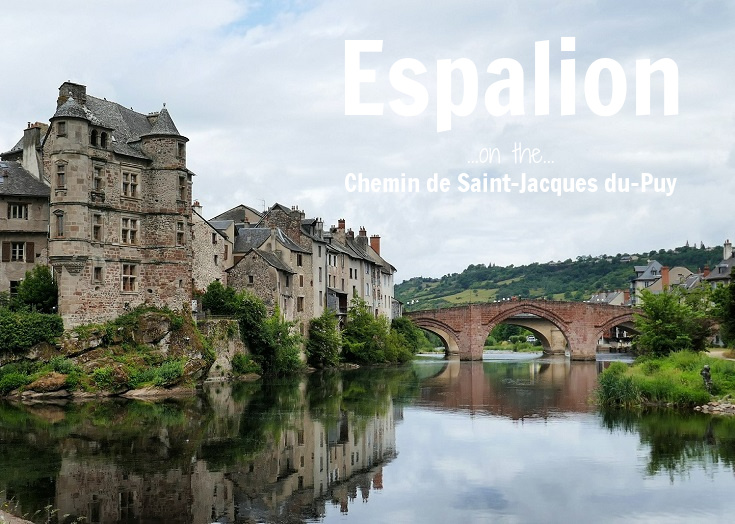
(Published February 2016, last updated February 2025)
So far the walk along the Chemin de Saint-Jacques du-Puy has passed through many delightful villages. Most have been quite small and wandering around without getting lost has not been a problem. By comparison, Espalion is a large, busy town, with several grocery stores, pharmacies, banks and restaurants to choose from, but oozing with medieval charm.
My suggested itinerary will bring you to Espalion after a short morning walk from Saint-Côme-d’Olt, allowing plenty of time to visit the museums and wander through the charming back streets.
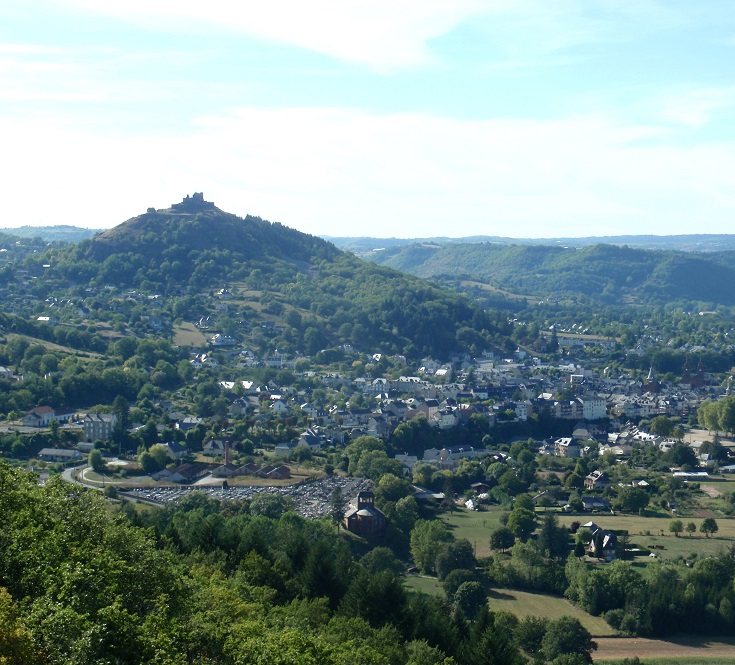
View of Espalion from La Vierge on the GR 65
The approach towards Espalion from Saint-Côme-d’Olt climbs a couple of challenging hills although, if you have a TopoGuide or other good map, you can take a much easier route following the road along the river. You will however, miss this glorious view of the town, nestled into the valley alongside the river and watched over by the ruins of the fortified château Calmont d’Olt.
The GR 65 path and the variante non balisée from Saint-Côme-d’Olt meet on the edge of town at l’église de Perse.
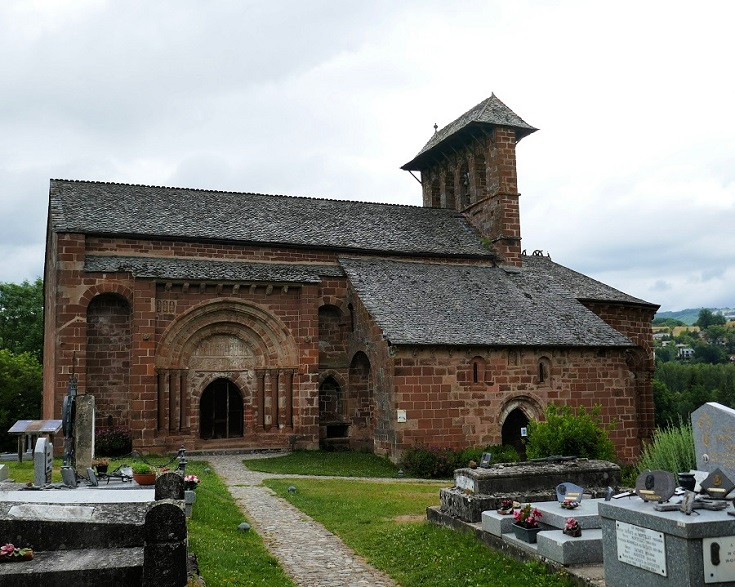
Twelfth-century Église de Perse at the entrance to Espalion
This beautiful church was built during the eleventh and twelfth centuries and holds the relics of a local saint, Hilarian, who was decapitated by the Sarrazins in the eighth century. Église de Perse was the parish church for 400 years until the construction of the much grander church of Saint-Jean-Baptiste in the sixteenth century.
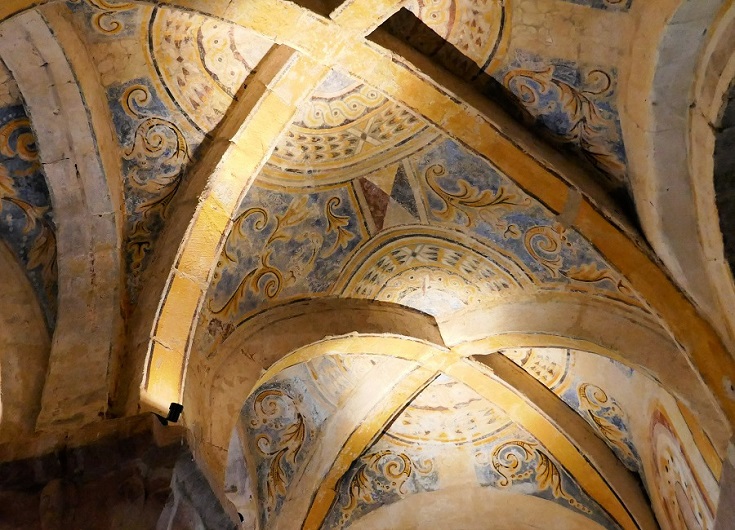
Frescoes adorn the ceiling inside Église de Perse
The first time I arrived in Espalion, I had followed the hilly route from Saint-Chély-d’Aubrac and was too tired to climb the slight hill to the chapel—an oversight I soon regretted, and rectified on my last visit. Inside, you’ll find beautifully decorated ceilings and walls of deep red stone.
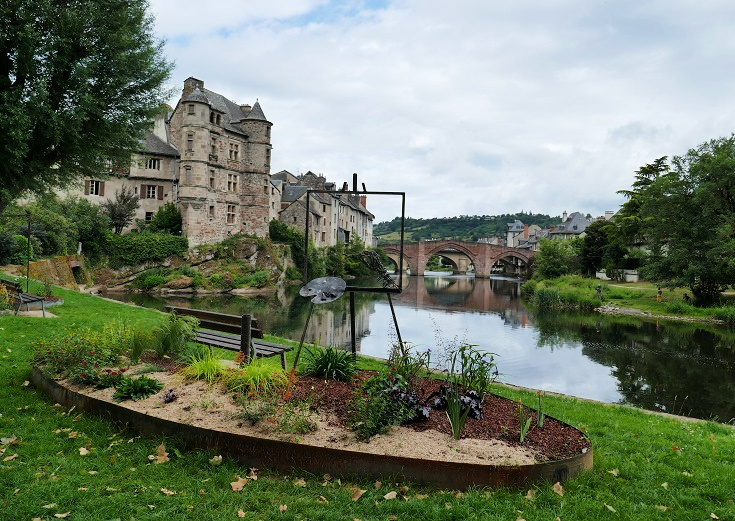
Medieval turrets and Pont-Vieux across the River Lot
As you reach town, a glance along the river will provide you first views of the old bridge—le Pont Vieux.
Records show that the bridge existed in 1060 and for many years boasted three towers and a drawbridge. At one time it housed around twenty shops and was a busy marketplace. It is now closed to traffic but in May, it still carries herds of cattle to summer pastures during Transhumance.
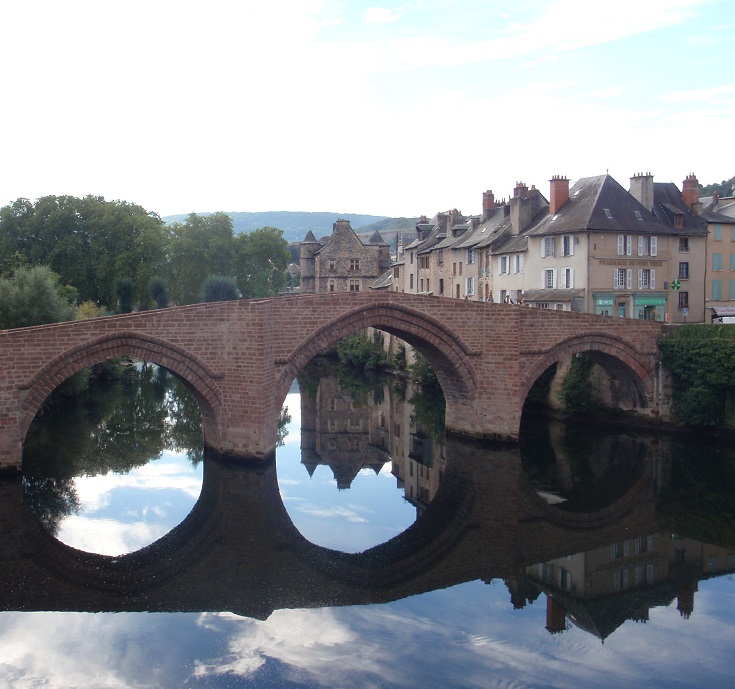
Pont-Vieux
On the far bank, between the two bridges, you’ll see the old tanneries where hides were washed in the river.
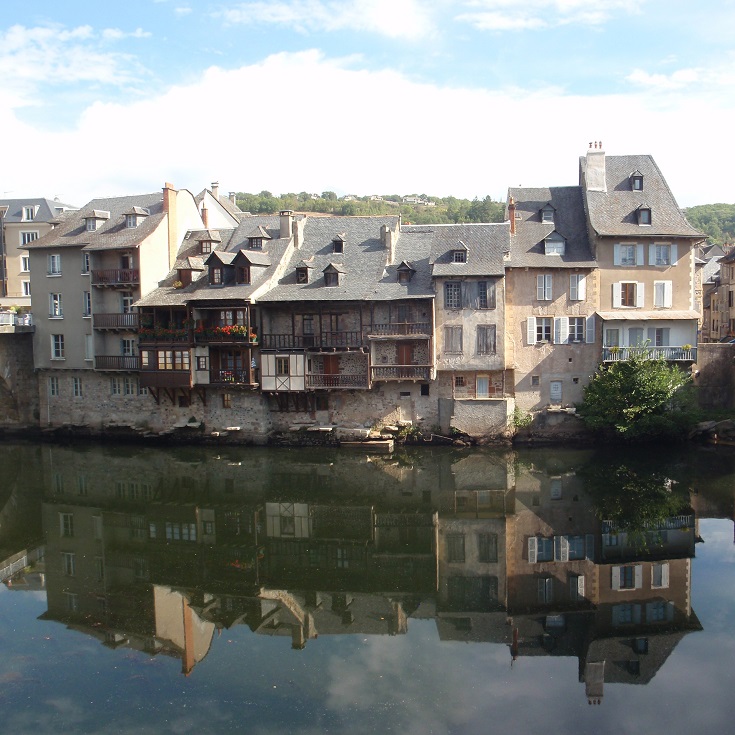
Medieval tanneries line the river
A short distance further along, the GR 65 path reaches the Tourist Office. Call in and ask for the map which highlights fifteen historical monuments or sights to discover as you walk around town.
On the main street you’ll pass the relatively modern parish church, built in the nineteenth century and featuring two, forty-five metre towers crowned with statues of Mary and Joseph.
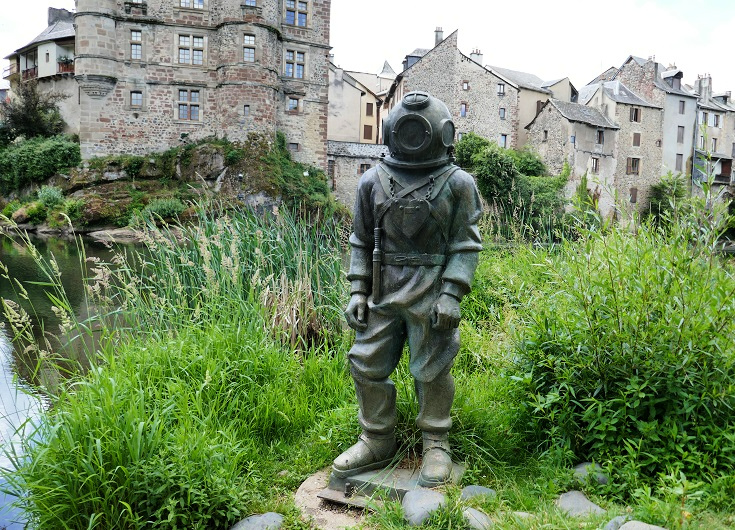
A statue on the banks on the river honours Auguste Denayrouze and Benoît Rouquayrol, inventors of the first modern diving equipment
In 1978, the older church, dedicated to Saint-Jean-Baptiste, became home to le Musée des Arts et Traditions Populaires and now displays artefacts from nineteenth-century daily life. The church also houses le Musée du Scaphandre (Diving Museum) in honour of Auguste Denayrouze and Benoît Rouquayrol – inventors of the first modern diving equipment – who were born near here and carried out their first experiments in the River Lot.
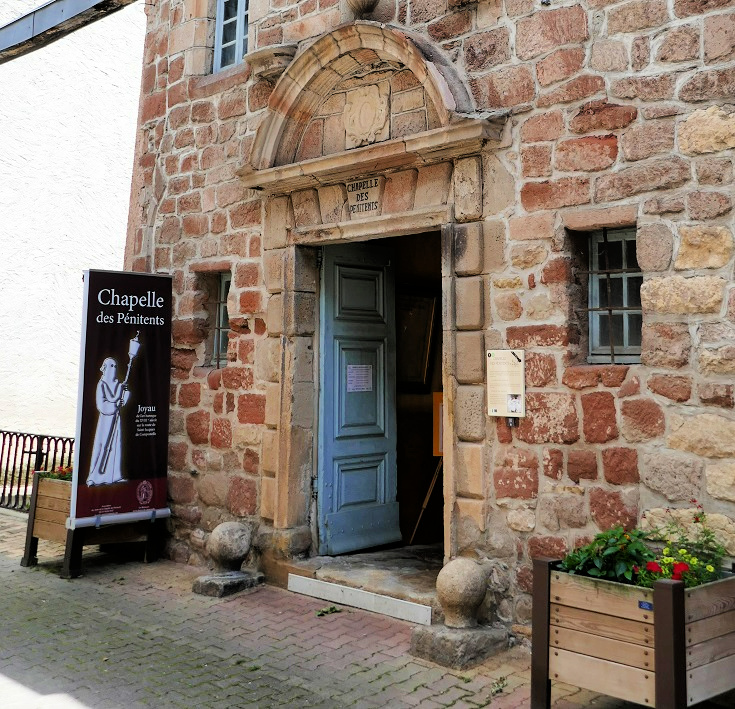
Chapelle des Pénitents Blancs
Tucked away at 29 Rue du Plô is the beautiful Chapelle des Pénitents Blancs. Built in 1700 with stones taken from the dismantled towers of Pont-Vieux, the interior is richly decorated in a baroque style.
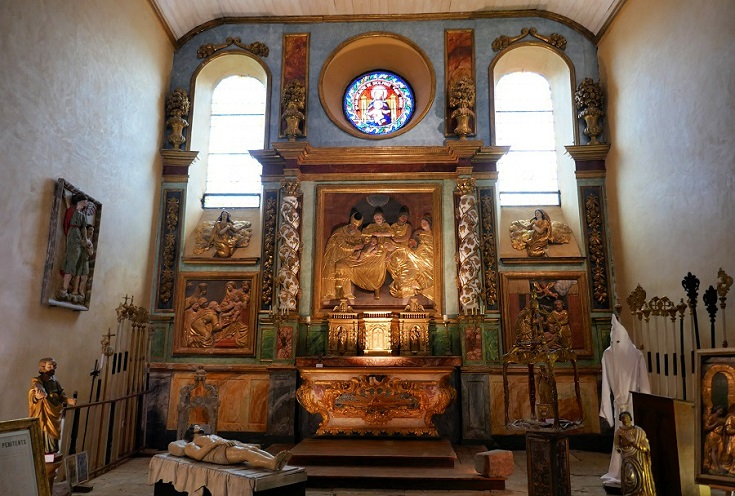
Inside Chapelle des Pénitents Blancs is richly decorated in the baroque style
The chapel opens at 2:30 on most afternoons and a team of volunteers offers guided visits (en français) explaining the history of the chapel and the role of the pénitents for a small fee.
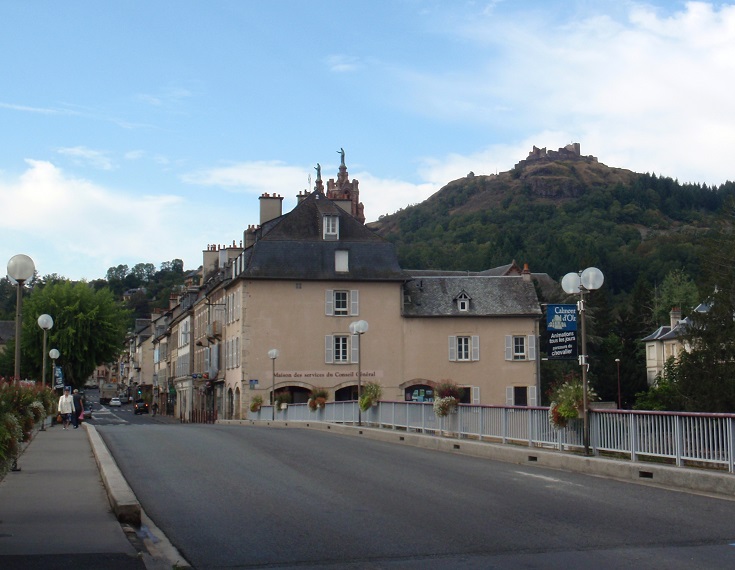
The main street of Espalion under the watchful eye of Château Fort de Calmont d’Olt
A few more kilometres up a fairly steep hill will lead you to Château Fort de Calmont d’Olt—the remains of a fortified castle.
The château offers an interesting insight into siege warfare during the Middle Ages. Guided tours and demonstrations show how soldiers attacked oncoming armies by catapulting boulders down the hill and tell the gruesome story of soldiers hurling decaying animal carcasses into enemy camps to inflict injuries and spread disease.
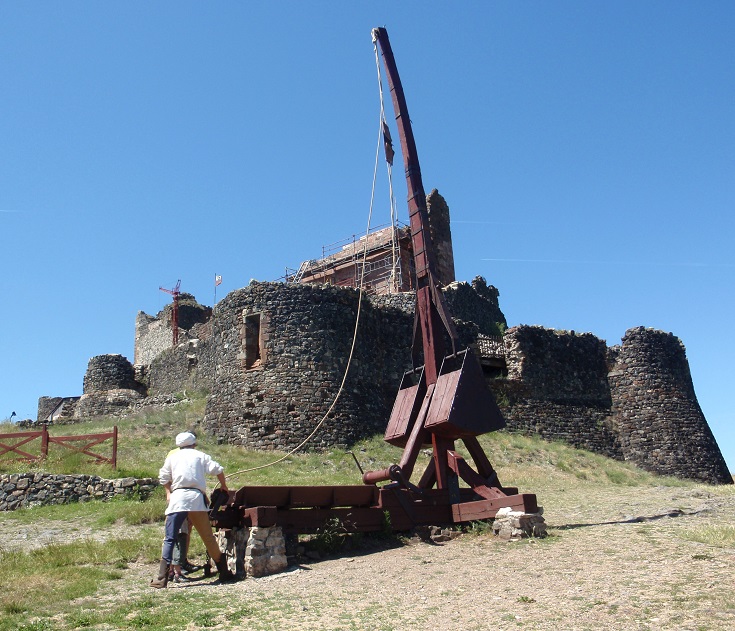
Catapult demonstration at Château Fort de Calmont d’Olt
I’ll admit that as I walked along the Chemin de Saint-Jacques, a visit to the fortified château required a climb of one hill too many, but I had called in on a previous visit. If you’d like to see it, take a taxi up the hill and perhaps on to Bessuéjouls to continue your walk afterwards.
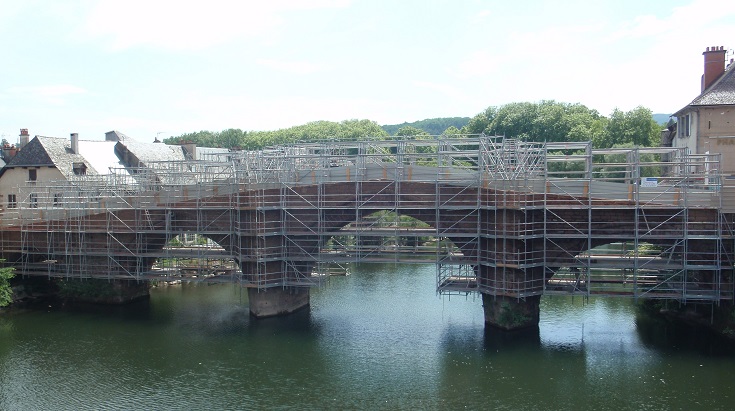
Pont-Vieux undergoing renovations in 2011
And a reminder that somewhere on your holiday, the sight you’ve been longing to see will be undergoing renovation and covered in scaffolding!
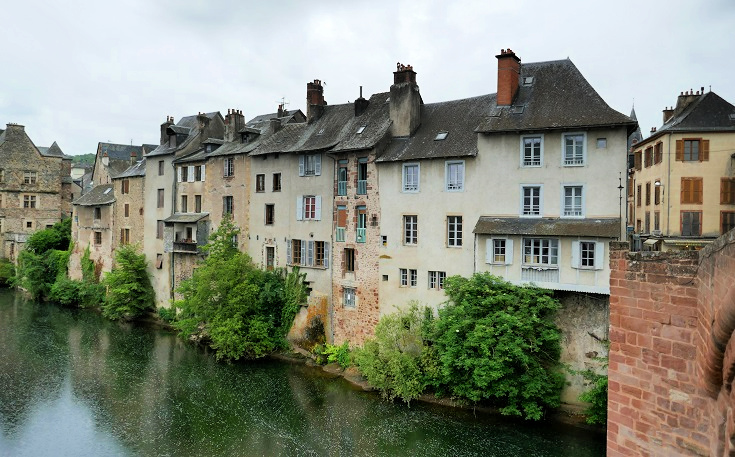
My bed for the night in Gîte le Pont-Vieux (two brown windows, top floor, fifth building along from the bridge)
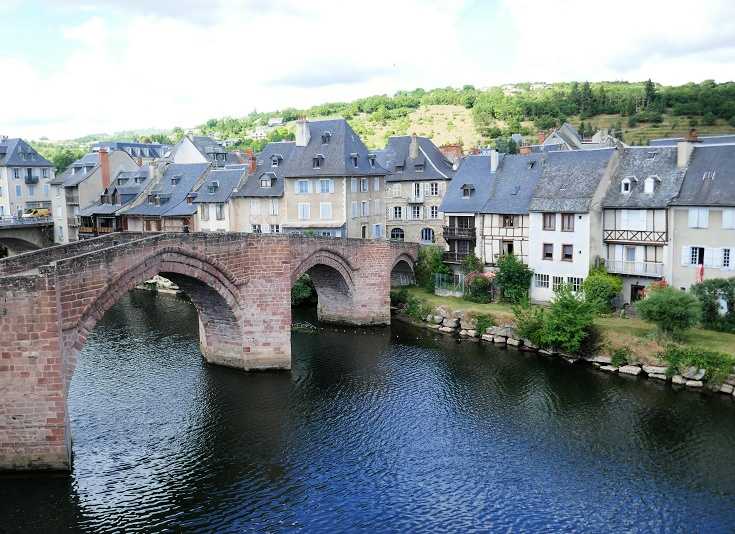
…and the view from my window
FAST FACTS
Which long-distance walk in France visits Espalion?
Chemin de Saint-Jacques du-Puy (Stage 2: Aumont-Aubrac to Figeac)
Look inside the CHEMIN DE SAINT-JACQUES (PDF) guidebook
Where is Espalion, France? Find it on Google maps
Espalion is located 156 kilometres (97.5 miles) along the Chemin de Saint-Jacques—a relaxed ten-day walk from the starting point of Le Puy-en-Velay but if you are pressed for time, Espalion can be reached quite comfortably in seven days without sacrificing any of the highlights.
Click through to find my suggested itinerary for all five stages of the walk or click through onto each of the five stages to find faster itineraries.
If you prefer to set your own agenda, I share the steps I take take to plan my itinerary on any long-distance walk.
Transport options to and from Espalion
The Compostel’Bus service runs every morning, connecting Espalion with villages along the path between Le Puy-en-Velay and Conques and making the return journey each afternoon. Other stops include Montbonnet, Saint-Privat-d’Allier, Monistrol-d’Allier, Saugues, Villeret-d’Apchier, La Chapelle-Saint-Roch (3 kms beyond le Sauvage), Saint-Alban-sur-Limagnole, Aumont-Aubrac, Nasbinals, Aubrac, Saint-Chély-d’Aubrac, Saint-Côme-d’Olt, Estaing, Golinhac, Espeyrac and Sénergues.
On week days, daily bus services (select Aveyron region) connect Espalion to Laguiole and Rodez (line 201) and to Estaing (line 212).
Tourist Office in Espalion
You’ll find the Tourist Office at Place du Plô, on your right soon after reaching the town. Opening hours are listed on the Tourist Office website.
If you didn’t collect a map of Espalion from the mairie in Saint-Côme-d’Olt, download one here (Découvrez Espalion). The map highlights fifteen historical monuments or sights to discover as you walk around town.
Chapelle des Pénitants opens at 14h30 on most afternoons, but you’ll find exact times throughout the year on their website.
Château Fort de Calmont d’Olt is open from 10h30 until 19h30 during July and August but hours are reduced at other times of the year. Check the website for opening hours and demonstration times.
Accommodation in Espalion
You’ll find a range of options for lodging in Espalion, including:
Hotel
Hôtel de France
Chambres d’hôtes
Appart Hôtel du Vieux Palais (6 rooms, 18 people)
Maison de la Prison (4 rooms, 8 people)
La Maison du Pèlerin (2 rooms, 4 people)
Au Jardin des Sens (2 rooms, 4 people)
Chambre d’hôte Sudres (1 room, 3 people)
Gîtes
La Halte Saint-Jacques (4 rooms, 18 people)
Au Fil de l’Eau (5 rooms, 15 people)
Le Pont-Vieux (3 rooms, 12 people)
Aux Portes des Monts d’Aubrac
Campground
Camping Roc de l’Arche
How to book accommodation in French
Where to eat in Espalion
There are many cafés and restaurants, as you’d expect in a town the size of Espalion. On most nights, you’ll have no trouble finding a good dinner, whether your preference is for pizza, something cheap and cheerful, or something more refined.
If your stay occurs on a Thursday night, you’ll be able to stock up on fresh fruit and trail mix at the fresh food market, held every Friday morning.
Practical tips for long-distance walking—preparation, packing and avoiding blisters
Purchase the Chemin de Saint-Jacques (PDF) guidebooks
Purchase five guidebooks covering Le Puy-en-Velay to Saint-Jean-Pied-de-Port
Look inside the CHEMIN DE SAINT-JACQUES (PDF) guidebook
